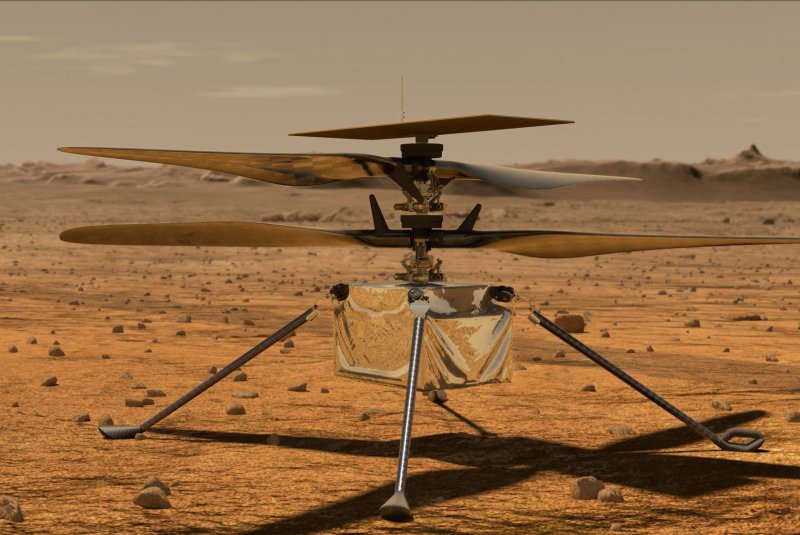1 of 6 | This is an illustration of NASA's Ingenuity Mars helicopter on Mars, where the space agency has decided to extend the aircraft's mission. Image courtesy of NASA |
License Photo
ORLANDO, Fla., April 30 (UPI) -- NASA's Mars helicopter Ingenuity has been so successful, the space agency said Friday it would extend the mission so the mini-aircraft can act as a scout for the rover Perseverance.
Engineers decided to let the helicopter operate another 30 days for longer flights to new areas of Jezero Crater, they announced in a press conference Friday. NASA originally planned to retire the helicopter at the end of April.
"We will be celebrating each day the Ingenuity survives and operates beyond the original window," said MiMi Aung, NASA's project manager for the aircraft.
NASA conducted the fourth flight of Ingenuity on Friday starting at 10:39 a.m. EDT. The helicopter climbed to 436 feet and then down, remaining in the air for 117 seconds, according to Aung.
"We also managed to capture lots of images during the flight with the color camera and with Ingenuity's black-and-white navigation camera, which tracks surface features as it flies," she wrote on a NASA blog.
"Images from that navigation camera are typically used by Ingenuity's flight controller and then thrown away unless we specifically tell the helicopter to store them for later use.
"During this flight, we saved even more images than we did on our previous flights: about 60 total during the last 164 feet before the helicopter returned to its landing site."
Referring to the extension of the helicopter's life, she wrote, "It's like Ingenuity is graduating from the test demo phase to a new phase ... where we can show how such a rotorcraft can be used."
Engineers tested Ingenuity in laboratory chambers on Earth, where it usually was tethered by a cable and where they tried to simulate the thin Martian atmosphere, Aung noted.
But the 4-pound helicopter appears to be thriving in its intended environment, untethered and free, she said. Her impression is that the rover Perseverance enjoys filming Ingenuity, she said with a laugh.
"Ingenuity loves Mars," Aung said.
Ingenuity became the first powered, controlled aircraft to fly on another planet April 19. But NASA designed it only for a 30-day technology demonstration to see if such flight was possible.
Perseverance was to drive away from Ingenuity, stranding it, because the rover's mission is to drill for rock samples that may show signs of ancient life on Mars.
Ingenuity needs Perseverance to communicate with Earth through the Mars Reconnaissance Orbiter that circles the Red Planet.
But the helicopter's flawless performance and healthy power and communications systems prompted the agency to consider the extension.
Two other factors also contributed to making such an extension possible, said Jennifer Trosper, the deputy project manager.
"Originally, we thought that we would be driving away from the location that we landed at, but that's not true," Trosper said. "The science team is actually very interested in getting the initial samples from this region that we're in right now."
Ingenuity's communications link with Perseverance also proved much stronger than expected, meaning the two robotic explorers could be a mile away from each other, NASA officials said.
NASA plans for the helicopter to scout for paths or obstacles the rover may encounter. It also is to take photos of rough terrain over which the rover can't travel, enhancing NASA's knowledge of the Martian surface and possibly guide future missions.
But the helicopter likely won't survive indefinitely, said J. "Bob" Balaram, Ingenuity's chief engineer. Harsh temperature swings in the crater -- from single digits to minus-117 degrees F -- most likely will degrade components over time, Balaram said.
"It's been riding the winds, it's been taking off great, it's been hovering, everything's working very well," Balaram said. "But it wasn't really designed for a long mission. ... So the expectation is that at some point, due to the thermal cycling, a joint or something will snap."
NASA will keep a small staff on the Ingenuity team to plan future flights, and such personnel will add to the mission costs, but any increase will be minimal with the potential for valuable discoveries, said Lori Glaze, director of NASA's Planetary Science Division.
Glaze expects teams of NASA scientists to propose new aerial drones for interplanetary missions in the coming years, based in Ingenuity's success.
But she said the next planned Mars mission, a rover that will collect Perseverance's rock samples and launch them into Martian orbit, already is too complicated and most likely will not include an aircraft.
NASA's Perseverance Mars rover, using its Mastcam-Z camera system, captured this view of the Martian sunset on November 9, 2021, the 257th Martian day, or sol, of the mission. Martian sunsets typically stand out for their distinctive blue color as fine dust in the atmosphere permits blue light to penetrate the atmosphere more efficiently than colors with longer wavelengths. But this sunset looks different: Less dust in the atmosphere resulted in a more muted color than average. The color has been calibrated and white-balanced to remove camera artifacts. Photo courtesy of NASA |
License Photo
















